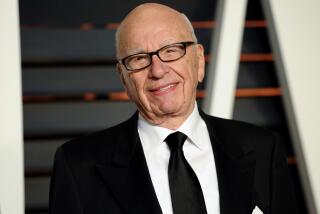NASD Proposes Analyst Rules
- Share via
Regulators proposed financial disclosure rules for stock analysts Monday, including the first regulations governing their TV appearances, as they seek to restore the public’s faith in Wall Street.
The plan by the National Assn. of Securities Dealers would force analysts to reveal their financial conflicts of interest in the stocks they follow.
Analysts would have to tell investors if they have a financial stake in a company. They also would have to disclose if the firm for which they work owns 5% or more of a company’s shares.
In addition, analysts would have to divulge any investment banking work their firm had done for a company in the last year. Finally, analysts would have to make such disclosures prominently and not bury them in the fine print of their reports.
“There’s no way for anybody to remove all of the conflicts of interest,” said Mary Schapiro, president of the NASD’s regulatory unit. “But this goes a long way toward disclosing what those conflicts are and giving investors the information they need to make a little bit more discerning judgment.”
Recognizing the influence of financial news channels such as CNBC and financial news shows such as “Wall Street Week With Louis Rukeyser,” analysts also would have to reveal such conflicts when they are interviewed on TV. Securities regulators have long worried about the cult of celebrity surrounding high-profile stock analysts who appear regularly on TV.
The proposal by the NASD unit comes after a year in which Wall Street’s credibility was badly damaged.
Even as prices of technology stocks crumbled in last year’s stock market meltdown, many analysts kept touting the shares of highly speculative companies. That was due, critics said, to their conflicts of interest.
Rather than being paid solely on the quality of their research, analyst compensation often is tied to their firms’ ability to generate investment banking business. That has made analysts reluctant to downgrade companies, as has the fact that many analysts also own shares of the companies they cover.
Though analyst conflicts are well-known to professional investors, they generally are not recognized by individuals. The issue has become critical in recent years as online investors have gotten greater access to analyst research reports.
A congressional subcommittee held a hearing on analyst objectivity last month, and a second hearing is tentatively planned for August.
The NASD proposal “is a good first step,” said Michael DiResto, spokesman for Richard H. Baker (R-La.), chairman of the House subcommittee on capital markets, which held the hearing. “But it does not address all of the problems.”
The NASD proposal would have to be approved by the Securities and Exchange Commission. Brokerage firms have until Aug. 15 to submit comments.
The Securities Industry Assn., a Wall Street trade group that issued its set of “best practices” guidelines for analysts in June, said it generally agreed with the NASD plan.
“This seems to be seeking the same things that we are seeking,” said Stuart Kaswell, SIA general counsel.
Several firms, such as Merrill Lynch & Co. and Citigroup Inc.’s Salomon Smith Barney, declined to comment.
Barbara Roper, director of investor protection for the Consumer Federation of America, said the proposal “looks like a genuine attempt to expose conflicts of interest.”
But she worried that no rule could overcome all of Wall Street’s tangled conflicts of interest. For example, an analyst could issue a favorable report to win a company’s investment banking business--something that would not be reported under the proposed NASD rules.
Paul Capelli, a CNBC spokesman, said his network supported the TV disclosure rules. CNBC already checks for analysts’ conflicts and discloses them on the air, he said.
More to Read
Inside the business of entertainment
The Wide Shot brings you news, analysis and insights on everything from streaming wars to production — and what it all means for the future.
You may occasionally receive promotional content from the Los Angeles Times.










